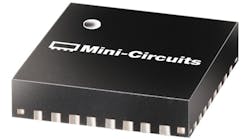Model DVGA1-242+ is a digitally controlled variable gain amplifier; it combines a high-gain E-PHEMT amplifier with a wide-dynamic-range step attenuator, and is fabricated using CMOS on silicon. The end result is a variable gain amplifier with 30-dB nominal gain at 0-dB attenuation that features a 31.5-dB gain control range from 0.45 to 2.40 GHz. The digitally controlled attenuator includes a 6-b serial interface for fast switching and 0.5-dB step resolution. The attenuation accuracy is typically 0.1 dB. The amplifier achieves +23 dBm output power at 1-dB compression, with an output third-order intercept point of typically +35.2 dBm at 450 MHz and +37 dBm at 2.40 GHz. The amplifier and attenuator combination, which is supplied in a 5 x 5 mm surface-mount MCLP package, runs on supplies of +3 and +5 VDC. It is suitable for cellular communications and Global Positioning System (GPS) receivers, among many other applications.
Mini-Circuits, P.O. Box 350166, Brooklyn, NY 11235-0003; (718) 934-4500, FAX: (718) 332-4661, www.minicircuits.com.
